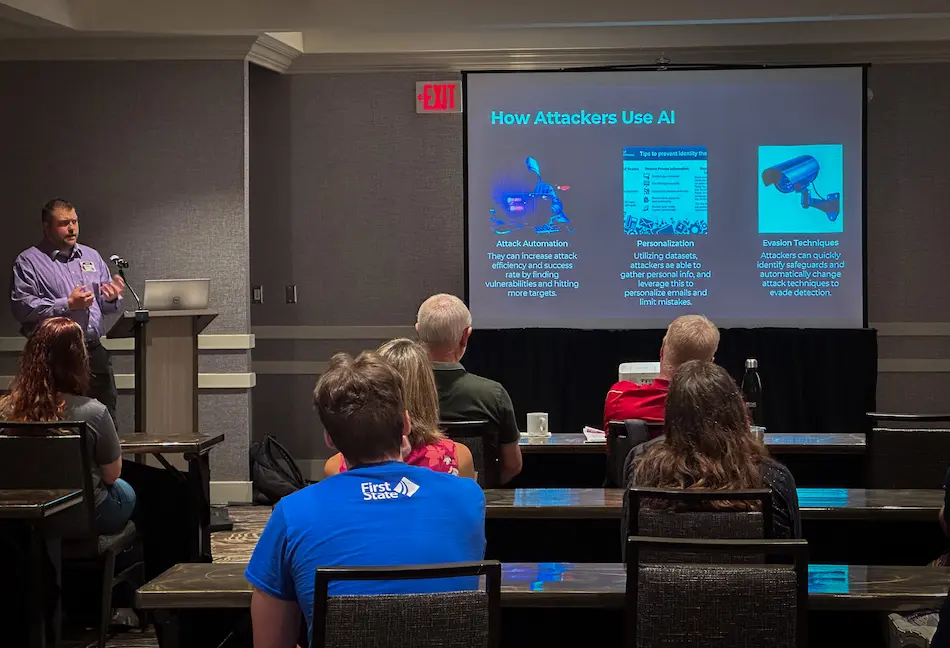Employees Play a Role in your Cybersecurity Posture
Businesses are in an imperative era, where being aware of cyberthreats and prioritizing robust cybersecurity measures is crucial in protecting their business from significant harm. Even the strongest cybersecurity defenses can be breached if an equal level of focus isn’t dedicated to establishing a comprehensive employee cybersecurity training program.
Why, you might wonder? Cybercriminals have grown more sophisticated in their tactics and discovered that directing their efforts towards uninformed employees can serve as the loophole through which they can infiltrate your data.
Strengthening employee cybersecurity awareness is an essential foundation for protecting your enterprise. In this blog, we will explore the factors that make employees vulnerable targets for cybercriminals and emphasize the critical importance of enhancing their security consciousness. By identifying vulnerabilities and taking proactive measures, we empower your workforce to effectively counter cyber attacks.
Why Cybercriminals Target Employees
Lack of Awareness
One of the primary factors that make employees susceptible to cybercriminals is their lack of awareness regarding prevalent cybersecurity threats, strategies, and recommended practices. Exploiting this knowledge gap, cybercriminals can employ tactics such as phishing attacks, malware infections, and social engineering schemes to target your employees.
Access to Sensitive Information
Employees often have access to sensitive information and critical systems that cybercriminals are eager to exploit. By compromising your employees’ accounts, cybercriminals can gain unauthorized entry to valuable assets, causing chaos within your organization.
Social Engineering Tactics
Cybercriminals are cunning masters of manipulation, utilizing sophisticated social engineering tactics to deceive employees into revealing sensitive information, unwittingly compromising security measures, or sharing login credentials. These clever tactics exploit fundamental human emotions such as trust, curiosity, and fear, effectively turning your employees into unwitting accomplices in cybercrime.
The Rise in BYOD
As the popularity of the Bring Your Own Device (BYOD) trend continues to rise, organizations face a new set of risks. With employees accessing business information and systems from their personal devices, which often lack the robust security controls of company-issued devices, cybercriminals find new vulnerabilities to exploit.
Challenges in the Era of Remote and Hybrid Work
As organizations embrace remote and hybrid work arrangements, a new set of security challenges arises. Businesses like yours must navigate the risks posed by unsecured home networks, shared devices, and the distractions of remote work. These factors can divert employee attention from cybersecurity best practices, leaving them more vulnerable to potential attacks.

Key Strategies for Creating an Effective Employee Cybersecurity Training Program
To enhance the cybersecurity of your organization, establish an interactive employee cybersecurity training program that incorporates these proven methodologies:
Assess Your Employees Collective Knowledge of Cybersecurity Best Practices
To effectively address your organization’s cybersecurity needs, it is imperative to thoroughly assess the specific risks it faces. By doing so, you can identify the areas where your employees may be most vulnerable to cyber threats. A great way to begin this evaluation process is by conducting a survey to gauge everyone’s knowledge. Additionally, partnering with a managed service provider (MSP) that specializes in cybersecurity can be highly beneficial. They can assist by deploying phishing simulation emails to your workforce, allowing you to accurately gauge their understanding and awareness of potential cyber risks.
Define Your Cybersecurity Training Goals
After identifying the knowledge gaps within your workforce, it is crucial to establish your objectives for implementing a cybersecurity training program. Define clear and specific goals for the training, outlining the desired outcomes and essential skills that employees should acquire. This will ensure a focused and effective approach to enhancing cybersecurity awareness and preparedness within your organization.
Craft Compelling Material
Create engaging and interactive training materials that are specifically designed for your employees. Integrate real-world scenarios and examples to make the content relatable and memorable. Collaborating with an MSP can also be advantageous in delivering this training effectively.
Implement Continuous Training
Implement a consistent and continuous training program to strengthen cybersecurity awareness and cultivate a culture of continual learning. Keep your employees well-informed about the latest threats and preventative measures so they can stay one step ahead of cybercriminals.
Assess the Impact and Gather Input
Consistently measure the effectiveness of your cybersecurity training program through comprehensive assessments and feedback mechanisms. By collecting valuable data, you can refine and enhance the program to ensure its continued success in protecting your organization from cyber threats.
Nurture a Culture of Cybersecurity
Inspire your employees to actively engage in cybersecurity by fostering an environment of open communication, promoting incident reporting, and instilling a shared responsibility for securing company assets.
Partner for Employee Cybersecurity Awareness Success!
Looking for expert assistance in implementing your employee cybersecurity training program? Collaborate with Prime Secured to strengthen your workforce’s knowledge of cybersecurity from within. Contact us today to access a robust security awareness training program that effectively engages your team and bolsters your organization’s defenses against evolving cyberthreats.
By investing in employee security awareness, you can transform your workforce into a powerful line of defense, safeguarding your business from cybercriminals and ensuring a more resilient future.




